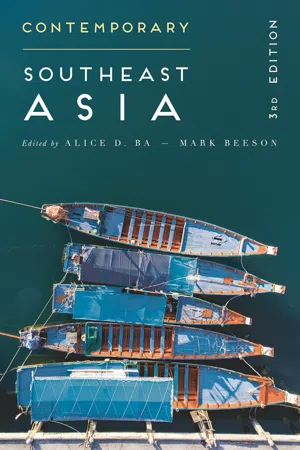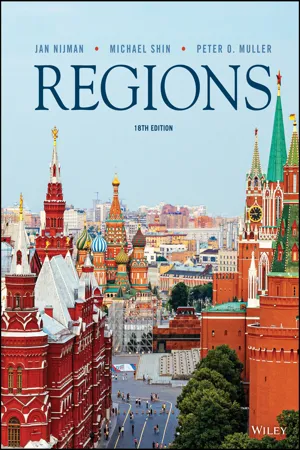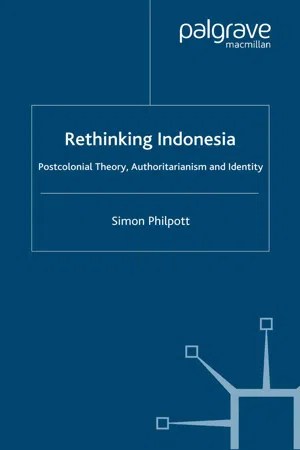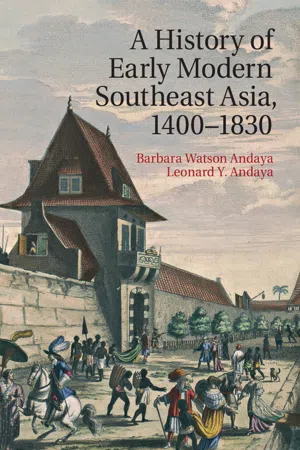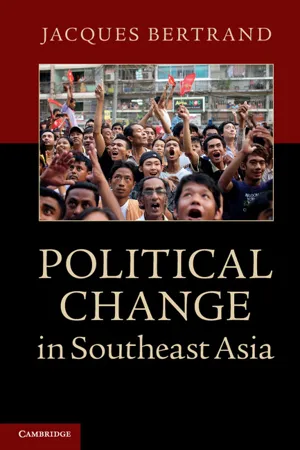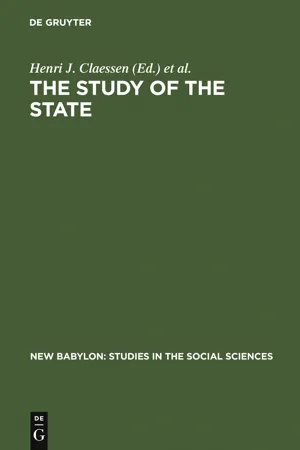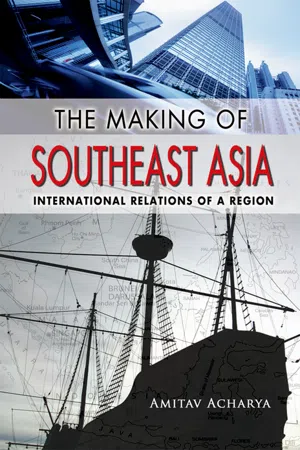History
Southeast Asian Kingdoms
The Southeast Asian Kingdoms refer to a group of historical states that existed in the region of Southeast Asia, including present-day countries such as Thailand, Cambodia, Laos, and Myanmar. These kingdoms were characterized by their unique cultural and political developments, including the influence of Indian and Chinese civilizations, the establishment of powerful monarchies, and the spread of Buddhism and Hinduism.
Written by Perlego with AI-assistance
Related key terms
1 of 5
8 Key excerpts on "Southeast Asian Kingdoms"
- eBook - PDF
Contemporary Southeast Asia
The Politics of Change, Contestation, and Adaptation
- Alice D. Ba, Mark Beeson, Alice D. Ba, Mark Beeson(Authors)
- 2017(Publication Date)
- Red Globe Press(Publisher)
17 Chapter 2 Southeast Asia: Historical Context Robert Cribb Southeast Asia’s contemporary international and political order is the prod-uct of long historical processes, beginning with the emergence of the first identifiable kingdoms more than two thousand years ago. Deeply rooted geopolitical forces underpin the region’s contemporary political structures, but those forces have been shaped by successive layers of historical experi-ence. At the same time, the region’s history is also a resource from which its peoples and rulers draw selective lessons. Patterns of civilization The underlying geopolitical feature of Southeast Asia is its division into around half a dozen major power centres which have historically been the core of distinct civilizations. Four of these centres were based in river valleys, where broad alluvial plains and abundant water enabled people to cul-tivate rice in paddy fields. These rivers – the Red River in present-day northern Vietnam, the lower Mekong, the Chao Phraya in what is now Thailand (formerly Siam), and the Ayeyarwady (Irrawaddy) in today’s Myanmar (formerly Burma) – were also conduits for valuable products from deeper in the interior: gold, gems, aromatic gums, bird feathers and exotic animal organs. And they gave their civilizations access to the sea, a high road for the exchange of goods and ideas. Vietnamese, Cambodian, Thai and Burmese civilizations grew in these favourable crucibles. The civilizational centres in island Southeast Asia depended less on rivers. The Malay cultural world developed on the shores of the Strait of Melaka, for more than two thousand years a choke-point on the trade route between India and China. Ports on the Strait provided an entrepôt for forest products from the interior of Sumatra. Java’s wealth in turn depended on the rich soils produced by its many volcanoes. Narrow but fertile valleys and coastal - eBook - PDF
Geography
Realms, Regions, and Concepts
- Jan Nijman, Michael Shin, Peter O. Muller(Authors)
- 2020(Publication Date)
- Wiley(Publisher)
From there, than Malacca to accommodate the bigger steamships of the time, Singapore swiftly rose to prominence as the British con- solidated their power over this key corner of the world. Most important, Singapore today is a symbol of modernity, a model for Southeast Asia’s future. Throughout the realm, those who can afford it go there to shop, to connect to inter- continental flights, to transact business, to invest in real estate, or to send their children to one of the city-state’s highly ranked universities. Prospects of Realm-Wide Integration: ASEAN The overall development of Southeast Asia still has a long way to go. Political stability and increased regional integration will facilitate the process, and that is the long-term goal of ASEAN [11], the Association of Southeast Asian Nations. Founded dur- ing the late 1960s, this supranational organization has primar- ily been concerned with security. But that has been a constantly challenging effort because a wide range of conditions mark its ten member-states. With the lone exception of minuscule East Timor (which has long sought to join), ASEAN encompasses all of the realm’s countries. These include one influential city-state (Singapore), an Islamic oil state (Brunei), two impoverished communist regimes (Vietnam and Laos), and a reforming mil- itary dictatorship whose population is rising from the ranks of the world’s most deprived (Myanmar). Another problem that ASEAN has failed to resolve, one that literally affects health across much of this realm, is the recurrent air pollution caused by Indonesia’s massive, human- ignited forest fires. - eBook - PDF
Rethinking Indonesia
Postcolonial Theory, Authoritarianism and Identity
- S. Philpott(Author)
- 2000(Publication Date)
- Palgrave Macmillan(Publisher)
95 3 Imagining Southeast Asia: Power and Knowledge in the Formation of a Southeast Asian Politics Studies Discourse Most Southeast Asianists . . . would sooner consider themselves botanists of the real, writing science, than zoologists of the un- real writing fiction. But each self-image is incomplete. To com- bine the two is to understand that those who first named and depicted the region as a whole wrote, without realizing it, a kind of science fiction, in which ‘Southeast Asia’, like ‘space- ship’, labeled something that did not exist – but eventually would. (Emmerson, 1984a, p. 1) To define, or to name, is to conquer. (Dirlik, 1992, p. 76) A genealogy of Southeast Asia Pre-colonial and colonial ideas of ‘region’ ‘Southeast Asia’ has become so commonplace in postwar international political discourse as to be quite unremarkable. It is a bifurcated region divided into mainland and maritime spheres. With the exception of Thailand, each of the countries of Southeast Asia was formally colonized and even Thailand’s autonomy was more apparent than real. It incorp- orates the world’s major religions; Islam, Buddhism (Theravada and Mahayana), Christianity and Hinduism. The majority of its people live in its low, wet and fertile areas, but there is also a substantial population 96 Rethinking Indonesia of so-called tribal or indigenous peoples who inhabit more rugged and less accessible areas, including cooler upland regions. Many of these peoples have an ambiguous, even hostile, relationship with Southeast Asia’s postcolonial governments. Up until the crash of 1997–98, capitalist Southeast Asian states industrialized, urbanized and ‘developed’ at such a pace that they were called ‘miracle economies’ or ‘tiger economies’. In contrast, socialist Southeast Asia languished and was more or less bypassed by the economic boom times until socialist orthodoxies were replaced by capitalist market economics. A wide variety of regime types are found in the region. - Barbara Watson Andaya, Leonard Y. Andaya(Authors)
- 2015(Publication Date)
- Cambridge University Press(Publisher)
2 In the early 1960s even Coedès began to speak of “Southeast Asia,” while the strategic interests of the region’s new nation- states encouraged greater collaboration, notably through the Association of Southeast Asian Nations (ASEAN), founded in 1967. By 1999 ASEAN had expanded to incorporate all ten nations that officially made up the region, and Timor Leste’s application to become the eleventh member (following its independence from Indonesia in 2002) is currently under review. If anything, this long-standing historical debate on what constitutes “Southeast Asia” has highlighted the difficulties of writing a regional history. In the first place, the national borders by which Southeast Asia is differentiated from China, Bangladesh, India, and the islands of the Pacific Ocean are of relatively recent origin. Determined by European colonialists through Western-style agreements or by diplomatic collusion, these borders frequently imposed an artificial division between communities that have long been linked by ties of family, history, and culture. As this study will show, the contemporary political landscape can be misleading if applied retroactively to the early modern period, when the boundaries of modern nation-states did not exist, when populations could be highly mobile, and when ethnic identities were fluid and evolving. Second, even when the concept of “Southeast Asia” is accepted in principle, generalizations are difficult because differing religious beliefs, political systems, and historical experiences further complicate the linguistic and ethnic diversity that is said to be the defining feature of the region. To a considerable degree this diversity was a response to differences in the geographic environment. Though virtually the entire region lies within the tropics, “mainland” Southeast Asia is an extension of the Asian continent.- eBook - PDF
The Malay World of Southeast Asia
A Select Cultural Bibliography
- P. Lim Pui Huen(Author)
- 2018(Publication Date)
- ISEAS Publishing(Publisher)
16 POLITICAL ORGANIZATION SOUTHEAST ASIA Concepts of State & Authority 3968 Gesick, Lorraine, ed. Centers, Symbols, and Hierachies: Essays on the Classical States of Southeast As1a. Monograph Ser., no. 26. New Haven: Southeast As1an Stud1es, Yale Un1v., 1983. 241pp. DS513 C39 3969 Hall, Kenneth R., and Whitmore, John K., eds. Explorations in Early Southeast Asian History: the Origins of Southeast As1an Statecraft. M1ch1gan Papers on South and Southeast As1an Stud1es, no. 11. Ann Arbor: Center for South and Southeast Asian Studies, Univ. of Michigan, 1976. 358pp. DS514 Hl7 3970 Heine-Geldern, Robert. Conceptions of State and Kingship in Southeast Asia. Data Paper, no. 18. Ithaca, N.Y.: Southeast Asia Program, Dept. or-Asian Studies, Cornell Univ., 1956. 14pp. DS513 H46 3971 Isoart, Paul. Les E:tats de 1' Asie du Sud-Est. Paris: Economica, 1978. 275pp. JQ96 A2I85 3972 Mabbett, Ian, ed. Patterns of Kingship and Authority in Traditional Asia. London: Croom Helm, 1984. 320pp. 3973 Reid, Anthony, and Castles, Lance, eds. Pre-Colonial State Systems in Southeast Asia; the Malay Peninsula, Sumatra, Bah-Lombok, South Celebes. MBRAS Monograph, no. 6. Kuala Lumpur: Malays1an Branch of the Royal Asiatic Society, 1975. 135pp. JC325 C71 3974 Solomon, Robert L. Aspects of State, Kingship and Succession in Southeast Asia. Paper P-4380. Santa Mon1ca: Rand Corp., 1970. 13pp. JC'328. 5 Rl8P 3975 Wales, H. G. Quaritch. The Mountain of God: a Study in Early Religion and Kingship. London: B. Quar1tch, 1953. 174pp. 3976 Workshop on Malay Sultanates and Malay Culture, 1st. Papers presented at the First Workshop held in Kuala Lumpur, 21-24 Feb. 1977. Mimeo. DS509 W91 3977 Workshop on Malay Sultanates and Malay Culture, 2d. Second Workshop on Malay Sultanates and Malay Cutlure, 4th to 7th December 1978. 2 vols. 0Jung Pandang: Hasanudd1n On1v., 1978. M1meo. DS509 W91 3978 Workshop on Malay Sultanates and Malay Culture, 3d. Papers presented at the Third Workshop held in Kuala Lumpur, 1-4 Nov. - eBook - PDF
- Jacques Bertrand(Author)
- 2013(Publication Date)
- Cambridge University Press(Publisher)
Yet, it was not isolated. Traders, adventurers and conquerors criss-crossed Asia from the Indian subcontinent to the eastern tip of today’s China. With human flows also came the transmission of ideas, such as new religious beliefs. Links also stretched to the Roman Empire and different parts of today’s Europe. Political organization was vastly different from one location to the next. Most prominently, successive Han and Mongul dynasties con- trolled vast areas of Eastern Asia, spreading their political and cultural influences over neighbouring areas of today’s Southeast Asia. After Qin Shi Huangdi created the Chinese empire in 221–210 BC, the Chi- nese state became highly centralized and bureaucratized, as its influence expanded over the following centuries. Smaller surrounding kingdoms, such as the Viet or Korean kingdoms absorbed some of the Chinese cultural influences, while struggling to maintain their independence. In much of Southeast Asia, polities were a great deal smaller, and tended to change regularly. According to Lieberman, from the fourteenth cen- tury onwards, mainland Southeast Asia did see a greater consolidation over time, but archipelagic Southeast Asia remained more fluid. Some kingdoms were formed in parts of today’s Java, Bali, Maluku, and Cambodia, for instance, but they were held together often by kinship and religious ties rather than bureaucratic structure or territorial con- trol (Lieberman, 2003). The bases, scale and types of political orga- nization were therefore different across the region, and so were the modalities of legitimacy. Colonialism set a new course and began to transform this diverse landscape, through integrative and administrative changes that would eventually give way to the emergence of modern states. European influences deeply affected many societies, including their culture and modes of social organization. - eBook - PDF
- Henri J. Claessen, Peter Skalnik, Henri J. Claessen, Peter Skalnik(Authors)
- 2011(Publication Date)
- De Gruyter Mouton(Publisher)
This difficulty can be grasped easily enough by perusing the three Human Relations Area Files ethnological gazeteers (Lebar et. al. 1964, 1972, 1975) on mainland and insular Southeast Asian ethnic groups and trying to relate the various terms used for political leadership and organization to appropriate conventional comparative notions; or by taking more detailed analyses of particular cases. Leach (1960: 61), for example, describes '...a typical Burma state', as follows: It had from certain points of view a very real existence ...Yet in another sense it was a fiction. Its Shan inhabitants were widely scattered and by no means numerous. The Prince could only undertake effective political action The Southeast Asian state 457 with the aid and consent of the Hill 'subjects' who were not subjects at all. His claims regarding suzerainty were optimistic in the extreme...! believe that the Indian style states of 'Burma' history have been of this general type. Indeed other accounts suggest that such a general type of political organization was widespread throughout much of both mainland and insular Southeast Asia, as the following remarks on the Balinese 'state' indicate: When the Dutch entered Bali early in this century, the complex indigenous political system that they found was basically not territorial in nature. The many small competing kingdoms were dependent for their strength on personal ties between lords and their commoner subjects irrespective of their landholdings or place of residence. Nor were their boundary regions between kingdoms clearly defined. Usually they consisted of intermediate areas where villages or even subjects were scattered in among each other, living side by side. - eBook - PDF
The Making of Southeast Asia
International Relations of a Region
- Amitav Acharya(Author)
- 2012(Publication Date)
- ISEAS Publishing(Publisher)
122 For example, such perspectives pointed to how the use of Sanskrit, once widespread in government and religion, slowly waned as Southeast Asians used Indian scripts to develop written forms of their own languages. Once regarded in terms of their Indian heritage, the region’s symbolic and organizational features were now seen to be “merely redefinitions of indigenous institutions”. 123 Southeast Asians were not to be “regarded as recipients (or victims) of history, but as makers of it”. 124 A major turning point was the work of Dutch economic historian Van Leur, who described all foreign influences on Indonesia, including Hindu-Buddhism and Islam, as “only a thin, easily flaking glaze on the massive body of indigenous civilization”. 125 Scholars pointed to important variations between the original Indian and Chinese ideas and practices and those found in Southeast Asia. Examples ranged from Southeast Asia’s rejection or modification of the Indian caste system (the kings used the Indian caste system to describe themselves, but the caste system did not catch on in societies by and large) and the nature of Buddha images in Thailand (as they differed from Indian images) to the distinctive character of temple art in the Hindu-Buddhist kingdoms of Pagan, Angkor and Java. 126 Similarly, Tambiah argues that Indian Buddhist notions of kingship, including that of the Chakravartin, took a deep hold in Southeast Asia, assuming “an effective and enduring organizing role in the constitution of emergent societies”, yet this was not a matter of wholesale and unaltered transmission imposed by Indian rulers or merchants but a development that was “sought, appropriated, and transformed to suit a Southeast Asian context and milieu”. 127 86 The Making of Southeast Asia The new preoccupation of historians of Southeast Asia was to show how Indian culture and political ideas were “absorbed by the local population and joined to their existing cultural patterns”.
Index pages curate the most relevant extracts from our library of academic textbooks. They’ve been created using an in-house natural language model (NLM), each adding context and meaning to key research topics.
